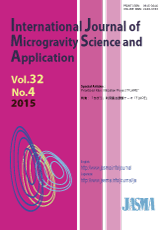32 巻, 4 号
「きぼう」利用重点課題テーマ「FLARE」
選択された号の論文の10件中1~10を表示しています
- |<
- <
- 1
- >
- >|
-
2015 年 32 巻 4 号 p. 320401-
発行日: 2015/10/31
公開日: 2020/05/14
PDF形式でダウンロード (214K) -
2015 年 32 巻 4 号 p. 320402-
発行日: 2015/10/31
公開日: 2020/05/14
PDF形式でダウンロード (696K) -
2015 年 32 巻 4 号 p. 320403-
発行日: 2015/10/31
公開日: 2020/05/14
PDF形式でダウンロード (1177K) -
2015 年 32 巻 4 号 p. 320404-
発行日: 2015/10/31
公開日: 2020/05/14
PDF形式でダウンロード (1285K) -
2015 年 32 巻 4 号 p. 320405-
発行日: 2015/10/31
公開日: 2020/05/14
PDF形式でダウンロード (1357K) -
2015 年 32 巻 4 号 p. 320406-
発行日: 2015/10/31
公開日: 2020/05/14
PDF形式でダウンロード (1237K) -
2015 年 32 巻 4 号 p. 320407-
発行日: 2015/10/31
公開日: 2020/05/14
PDF形式でダウンロード (652K) -
2015 年 32 巻 4 号 p. 320408-
発行日: 2015/10/31
公開日: 2020/05/14
PDF形式でダウンロード (926K) -
2015 年 32 巻 4 号 p. 320409-
発行日: 2015/10/31
公開日: 2020/05/14
PDF形式でダウンロード (1328K) -
2015 年 32 巻 4 号 p. 320410-
発行日: 2015/10/31
公開日: 2020/05/14
PDF形式でダウンロード (560K)
- |<
- <
- 1
- >
- >|
